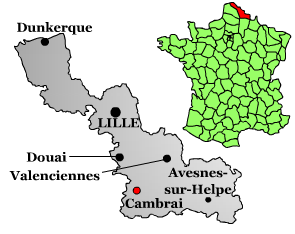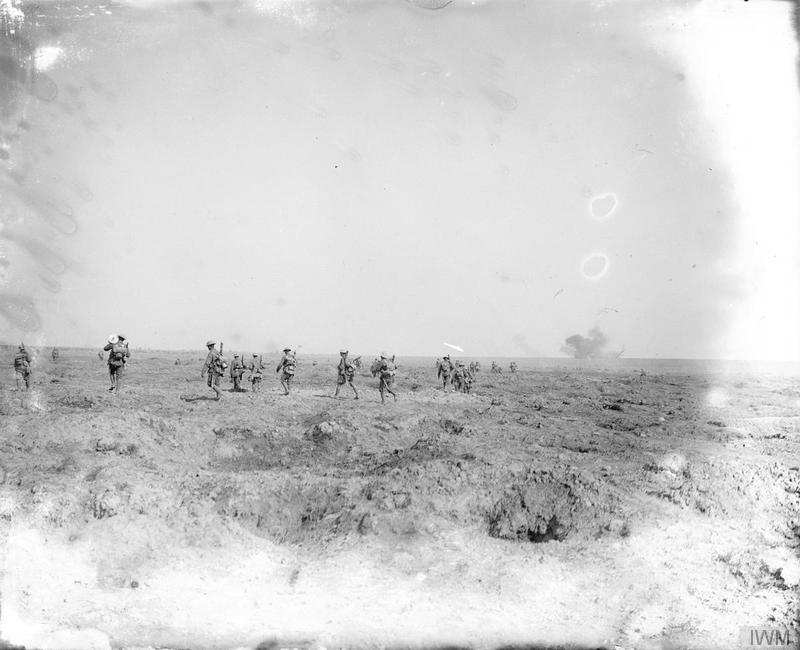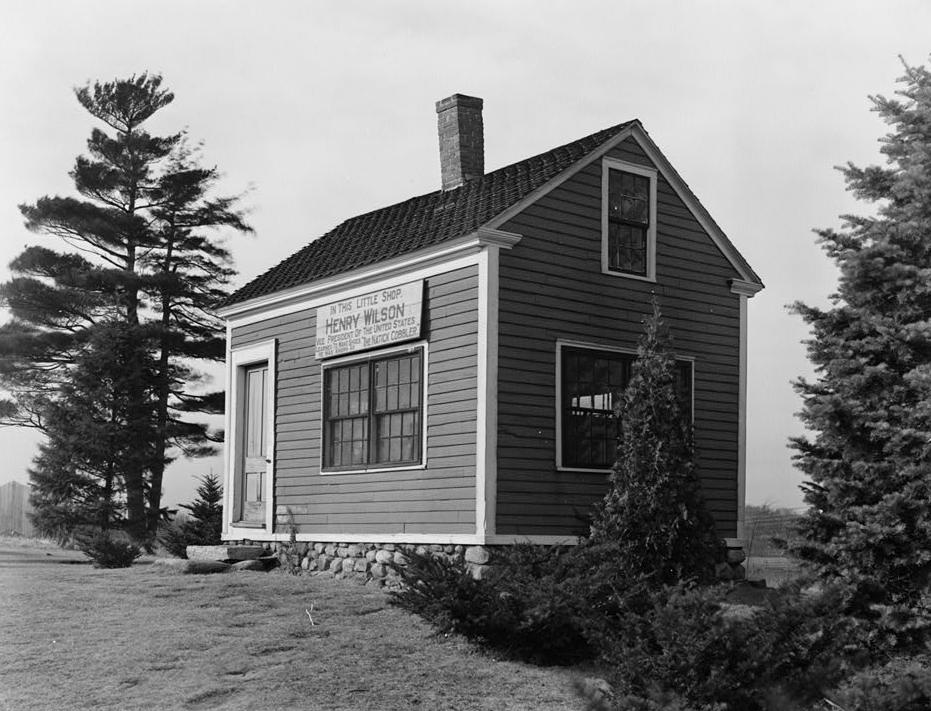|
Battle Of Le Cateau
The Battle of Le Cateau was fought on the Western Front during the First World War on 26 August 1914. The British Expeditionary Force (BEF) and the French Fifth Army had retreated after their defeats at the Battle of Charleroi (21–23 August) and the Battle of Mons (23 August). The British II Corps fought a delaying action at Le Cateau to slow the German pursuit. Most of the BEF was able to continue its retreat to Saint-Quentin. Prelude Having retreated from Mons two days earlier, Le Cateau and Mons being apart, the British II Corps (General Sir Horace Smith-Dorrien) was exhausted. The corps had become separated from the rest of the BEF because of the unexpected retreat by Sir Douglas Haig, the commander of I Corps, who had fought his own rearguard action at Landrecies on 25 August. Following that engagement, where Haig had rallied his troops, revolver in hand, he succumbed to panic, writing to the French High Command about the imminent debacle. He had greatly ov ... [...More Info...] [...Related Items...] OR: [Wikipedia] [Google] [Baidu] |
Great Retreat
The Great Retreat (), also known as the retreat from Mons, was the long withdrawal to the River Marne in August and September 1914 by the British Expeditionary Force (BEF) and the French Fifth Army. The Franco-British forces on the Western Front in the First World War had been defeated by the armies of the German Empire at the Battle of Charleroi (21 August) and the Battle of Mons (23 August). A counter-offensive by the Fifth Army, with some assistance from the BEF, at the First Battle of Guise (Battle of St. Quentin failed to end the German advance and the retreat continued over the Marne. From 5 to 12 September, the First Battle of the Marne ended the Allied retreat and forced the German armies to retire towards the Aisne River and to fight the First Battle of the Aisne . Reciprocal attempts to outflank the opposing armies to the north known as the Race to the Sea followed from Background Battle of the Frontiers, 7 August – 13 September The Battle of the Frontiers ... [...More Info...] [...Related Items...] OR: [Wikipedia] [Google] [Baidu] |
Douglas Haig, 1st Earl Haig
Field Marshal Douglas Haig, 1st Earl Haig, (; 19 June 1861 – 29 January 1928) was a senior officer of the British Army. During the First World War, he commanded the British Expeditionary Force (BEF) on the Western Front from late 1915 until the end of the war. He was commander during the Battle of the Somme, the Battle of Arras, the Third Battle of Ypres, the German Spring Offensive, and the Hundred Days Offensive.Sheffield 2002, p. 21.Sheffield 2002, p. 263.Hart 2008, p. 2. His military career included service in the War Office, where he was instrumental in the creation of the Territorial Force in 1908. In January 1917 he was raised up to the rank of Field Marshal, subsequently leading the BEF during the final Hundred Days Offensive, when it crossed the Canal du Nord and broke through the Hindenburg line, capturing 195,000 German prisoners. This campaign, in combination with the Kiel mutiny, the Wilhelmshaven mutiny, the proclamation of a republic on 9 November 1918 ... [...More Info...] [...Related Items...] OR: [Wikipedia] [Google] [Baidu] |
4th Infantry Division (United Kingdom)
The 4th Infantry Division was a regular infantry division of the British Army with a very long history, seeing active service in the Peninsular War, the Crimean War, the First World War, and during the Second World War. It was disbanded after the war and reformed in the 1950s as an armoured formation before being disbanded and reformed again and finally disbanded on 1 January 2012. Napoleonic Wars The 4th Division was originally formed in 1809 by Arthur Wellesley, 1st Duke of Wellington, as part of the Anglo-Portuguese Army, for service in the Peninsular War. It fought in the Battles of Talavera, Salamanca, Roncesvalles, Vitoria, the Pyrenees, Orthez, and Toulouse, and the siege of Badajoz. Peninsular War order of battle The order of battle from January 1812 was as follows: Major General Sir Charles Colville (to April 1812) Major General Lowry Cole (from June 1812) * 1st Brigade: Major General James Kemmis ** 3/27th (Inniskilling) Regiment of Foot ** 1/40th (2nd Somerse ... [...More Info...] [...Related Items...] OR: [Wikipedia] [Google] [Baidu] |
3rd Division (United Kingdom)
The 3rd (United Kingdom) Division is a regular army division of the British Army. It was created in 1809 by Arthur Wellesley, 1st Duke of Wellington, as part of the Anglo-Portuguese Army, for service in the Peninsular War, and was known as the Fighting 3rd under Sir Thomas Picton during the Napoleonic Wars. The division fought at the Battle of Waterloo, as well as during the Crimean War and the Second Boer War. As a result of bitter fighting in 1916, during the First World War, the division became referred to as the 3rd (Iron) Division, or the Iron Division or Ironsides. During the Second World War, the division (now known as the 3rd Infantry Division) fought in the Battle of France including a rearguard action during the Dunkirk Evacuation, and played a prominent role in the D-Day landings of 6 June 1944. The division was to have been part of a proposed Commonwealth Corps, formed for a planned invasion of Japan in 1945–46, and later served in the British Mandate of Pale ... [...More Info...] [...Related Items...] OR: [Wikipedia] [Google] [Baidu] |
Cambrai
Cambrai (, ; pcd, Kimbré; nl, Kamerijk), formerly Cambray and historically in English Camerick or Camericke, is a city in the Nord department and in the Hauts-de-France region of France on the Scheldt river, which is known locally as the Escaut river. A sub-prefecture of the department, Cambrai is a town which had 32,501 inhabitants in 2018. It is in the heart of the urban unit of Cambrai with 46,772 inhabitants. Its functional area, a more extensive range, included 94,576 inhabitants in 2018.Comparateur de territoire: Aire d'attraction des villes 2020 de Cambrai (108), Unité urbaine 2020 de Cambrai (59403), Commune de Cambrai (59122) INSEE With |
5th Infantry Division (United Kingdom)
The 5th Infantry Division was a regular army infantry division of the British Army. It was established by Arthur Wellesley, 1st Duke of Wellington for service in the Peninsular War, as part of the Anglo-Portuguese Army, and was active for most of the period since, including the First World War and the Second World War and was disbanded soon after. The division was reformed in 1995 as an administrative division covering Wales and the English regions of West Midlands, East Midlands and East. Its headquarters were in Shrewsbury. It was disbanded on 1 April 2012. Peninsular War The 5th Division during the Peninsular War under the command of General James Leith was present at most of the major engagements including the Battle of Bussaco, the Battle of Sabugal, the Siege of Almeida, the Battle of Badajoz, the Battle of Salamanca, the Battle of Vitoria, the Siege of San Sebastian, the Battle of Nivelle and the Battle of the Nive. Peninsular War order of battle Th ... [...More Info...] [...Related Items...] OR: [Wikipedia] [Google] [Baidu] |
Map Commune FR Insee Code 59136
A map is a symbolic depiction emphasizing relationships between elements of some space, such as objects, regions, or themes. Many maps are static, fixed to paper or some other durable medium, while others are dynamic or interactive. Although most commonly used to depict geography, maps may represent any space, real or fictional, without regard to context or scale, such as in brain mapping, DNA mapping, or computer network topology mapping. The space being mapped may be two dimensional, such as the surface of the earth, three dimensional, such as the interior of the earth, or even more abstract spaces of any dimension, such as arise in modeling phenomena having many independent variables. Although the earliest maps known are of the heavens, geographic maps of territory have a very long tradition and exist from ancient times. The word "map" comes from the , wherein ''mappa'' meant 'napkin' or 'cloth' and ''mundi'' 'the world'. Thus, "map" became a shortened term referring to ... [...More Info...] [...Related Items...] OR: [Wikipedia] [Google] [Baidu] |
Indirect Fire
Indirect fire is aiming and firing a projectile without relying on a direct line of sight between the gun and its target, as in the case of direct fire. Aiming is performed by calculating azimuth and inclination, and may include correcting aim by observing the fall of shot and calculating new angles. Description There are two dimensions in aiming a weapon: * In the horizontal plane (azimuth); and * In the vertical plane (elevation), which is governed by the distance (range) to the target and the energy of the propelling charge. The projectile trajectory is affected by atmospheric conditions, the velocity of the projectile, the difference in altitude between the firer and the target, and other factors. Direct fire sights may include mechanisms to compensate for some of these. Handguns and rifles, machine guns, anti-tank guns, tank main guns, many types of unguided rockets (although missiles, mortars, howitzers, rocket artillery, multiple rocket launchers, and artille ... [...More Info...] [...Related Items...] OR: [Wikipedia] [Google] [Baidu] |
German Empire
The German Empire (), Herbert Tuttle wrote in September 1881 that the term "Reich" does not literally connote an empire as has been commonly assumed by English-speaking people. The term literally denotes an empire – particularly a hereditary empire led by an emperor, although has been used in German to denote the Roman Empire because it had a weak hereditary tradition. In the case of the German Empire, the official name was , which is properly translated as "German Empire" because the official position of head of state in the constitution of the German Empire was officially a " presidency" of a confederation of German states led by the King of Prussia who would assume "the title of German Emperor" as referring to the German people, but was not emperor of Germany as in an emperor of a state. –The German Empire" ''Harper's New Monthly Magazine''. vol. 63, issue 376, pp. 591–603; here p. 593. also referred to as Imperial Germany, the Second Reich, as well as simply Germa ... [...More Info...] [...Related Items...] OR: [Wikipedia] [Google] [Baidu] |
Henry Wilson
Henry Wilson (born Jeremiah Jones Colbath; February 16, 1812 – November 22, 1875) was an American politician who was the 18th vice president of the United States from 1873 until his death in 1875 and a senator from Massachusetts from 1855 to 1873. Before and during the American Civil War, he was a leading Republican, and a strong opponent of slavery. Wilson devoted his energies to the destruction of " Slave Power", the faction of slave owners and their political allies which anti-slavery Americans saw as dominating the country. Originally a Whig, Wilson was a founder of the Free Soil Party in 1848. He served as the party chairman before and during the 1852 presidential election. Wilson worked diligently to build an anti-slavery coalition, which came to include the Free Soil Party, anti-slavery Democrats, New York Barnburners, the Liberty Party, anti-slavery members of the Native American Party (Know Nothings), and anti-slavery Whigs (called Conscience Whigs). When the ... [...More Info...] [...Related Items...] OR: [Wikipedia] [Google] [Baidu] |
Edmund Allenby, 1st Viscount Allenby
Field Marshal Edmund Henry Hynman Allenby, 1st Viscount Allenby, (23 April 1861 – 14 May 1936) was a senior British Army officer and Imperial Governor. He fought in the Second Boer War and also in the First World War, in which he led the British Empire's Egyptian Expeditionary Force (EEF) during the Sinai and Palestine Campaign against the Ottoman Empire in the conquest of Palestine. The British succeeded in capturing Beersheba, Jaffa, and Jerusalem from October to December 1917. His forces occupied the Jordan Valley during the summer of 1918, then went on to capture northern Palestine and defeat the Ottoman Yildirim Army Group's Eighth Army at the Battle of Megiddo, forcing the Fourth and Seventh Army to retreat towards Damascus. Subsequently, the EEF Pursuit by Desert Mounted Corps captured Damascus and advanced into northern Syria. During this pursuit, he commanded T. E. Lawrence (''"Lawrence of Arabia"''), whose campaign with Faisal's Arab Sherifial F ... [...More Info...] [...Related Items...] OR: [Wikipedia] [Google] [Baidu] |
Wilkinson Bird
Major-General Sir Wilkinson Dent Bird, (4 May 1869 – 6 January 1943) was an officer of the British Army during the late-19th century and the First World War. Early career Dent was born in 1869, the son of J.D. Bird, a captain in the 20th Hussars. After studying at Wellington and the Royal Military College, Sandhurst, he took a commission as a second lieutenant in the Queen's Royal Regiment on 22 August 1888. He was promoted to lieutenant on 1 December 1890, and to captain on 21 April 1897. That year, he served with the Niger Expedition, where he was mentioned in despatches and received a brevet promotion to major on 6 June 1897. His next posting took him to the North-Western Frontier of India.''Who Was Who'' He served with his regiment in the Second Boer War, where he was present at the Relief of Mafeking and was again mentioned in despatches, but was severely wounded and returned home in 1900. For his service, he was awarded the Distinguished Service Order (DSO). Sta ... [...More Info...] [...Related Items...] OR: [Wikipedia] [Google] [Baidu] |

.jpg)




